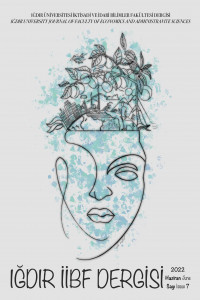Öğretmenlerin Örgütsel Destek Algılarının Demografik Özelliklere Göre İncelenmesi
Bu çalışmada, öğretmenlerin örgütsel destek algısı düzeylerinin belirlenerek bu düzeylerin bir takım demografik değişkenler açısından farklılaşıp farklılaşmadığı incelenmiştir. Alan araştırması 2018 yılında İstanbul’un Küçükçekmece ilçesinde bulunan okullardaki 348 öğretmenin katılımı ile yapılmıştır. Örgütsel Destek Algısı düzeylerini belirlemek için Eisenberger’in orijinal soru formundan yararlanılmış, demografik özelliklerin ölçülmesinde yaş, cinsiyet, medeni durum vb. ifadeler kullanılmıştır. Ölçüm aracının güvenilirlik ve geçerlilik analizleri gerçekleştirilmiştir. Bu bağlamda 66 kişilik bir pilot çalışma yapılmıştır. Hem pilot çalışma hem de ana çalışma verilerine faktör analizi uygulanmıştır. Soru formundan elde edilen verilerin aritmetik ortalamaları hesaplanmıştır. Gruplar arasında anlamlı düzeyde fark olup olmadığını saptamak amacı ile parametrik olmayan testlerden (Mann Whitney-U, Kruskal Wallis) faydalanılmıştır. Bulgulara göre öğretmenlerin sınıf mevcutlarına göre ve stajyerlerinin bulunma durumuna göre örgütsel destek algılarının farklılaştığı tespit edilmiştir.
Anahtar Kelimeler:
algılanan örgütsel destek, öğretmenler, demografik özellikler, İstanbul, Küçükçekmece
Examining Teachers’ Perceived Organisational Support in Scope of Demographic Characteristics
In this study, teachers’ perceived organizational support levels were measured and examined whether these levels differ in terms of some demographic variables. The field research was carried out at the schools in the Küçükçekmece district of Istanbul in 2018 with the participation of 348 teachers. Eisenberger’s original questionnaire’s short form was used to determine levels of Perceived Organisational Support. Age, gender, marital status, etc. expressions were used to observe the demographic characteristics. The reliability and validity analyses of the measurement tool were performed. In this context, a pilot study was conducted on 66 persons. Factor analysis was applied to both pilot study and main study data. The arithmetic averages of the data obtained from the questionnaire were calculated. Non-parametric tests (Mann Whitney-U, Kruskal Wallis) were used to determine if there was a significant difference between the groups. As a result of the analyses, there were significant differences between perceived organizational support levels of the teachers in terms of classroom size and having an intern.
Keywords:
perceived organizational support, teachers, demographic characteristics, Istanbul, Kucukcekmece,
___
- Buchanan, B. (1974). Building Organizational Commitment: The Socialization of Managers in Work Organizations, Administrative Science Quarterly,19: 533-546.
- Çakır, Ö. (2001). İşe Bağlılık Olgusu ve Etkileyen Faktörler, Ankara: Seçkin Yayınevi.
- Eisenberger, R., Cummings, J. ve Armeli, Lynch, S. P. (1997). Perceived Organizational Support, Discretionary Treatment and Innovation. Journal of Applied Psychology, 82: 812-820.
- Eisenberger, R., Fasolo, P. ve Davis-Lamastro, V. (1990). “Perceived Organizational Support and Employee Diligence, Commitment and Innovation”, Journal of Applied Psychology, 75:51- 59.
- Eisenberger, R., Huntington, R., Hutchison, S. ve Debora, S. (1986). Perceived Organizational Support. Journal of Applied Psychology, 71(3): 500-507.
- Eisenberger, R., Huntington, R., Hutchison, S., Sowa, D. (1986a). Does pay for performance increase or decrease perceived self-determination and intrinsic motivation. Journal of Personality and Social Psychology, 77: 1026-1040.
- Eisenberger, R., Huntington, R., Hutchison, S., Sowa, D. (1986b). Perceived Oganizational Support. Journal of Applied Psychology, 71,500-507.
- Erdoğan, İ. (1996). İşletme Yönetiminde Örgütsel Davranış, İstanbul: İşletme Fakültesi Yayınları.
- Hersey, P., Blanchard, K. H. (1993). Management of Organizational Behavior: Utilizing Human Resources, Prentice Hall, U.S.A.
- Koçoğlu, M. (2013). Çalışanların Örgütlerine Yönelik Girişimcilik Yönelimi Algıları, Örgüt Desteği, Kariyer Tatminleri ve İşten Ayrılma Niyetleri Arasındaki İlişkinin İncelenmesi: Otomotiv Sektöründe Bir Araştırma, İktisat Ve Girişimcilik Üniversitesi, Türk Dünyası Kırgız –Türk Sosyal Bilimler Enstitüsü Akademik Bakış Dergisi, (Sayı:35, Mart-Nisan).
- Kraimer, M. L. ve Wayne, S. J. (2004). An examination of perceived organizational support as a multidimensional construct in the context of an expatriateassignment. Journal of management,
- London, M. (1988). Organizational Support for Employees’ Career Motivation: A Guide to Human Resource Strategies in Changing Business Conditions, Human Resource Planning,11(1): 23-32.
- Malesta, R.M. ve Tetrick, L. E. (1996), “Understanding the Dynamics of Organizational and Supervisory Commmitment”, Society for Industrial and Organizational Society Annual Meeting, San Diego. 30(2): 209-237.
- Meyer, J. P., Allen, N. J. ve Gellatly, I. R. (1990). Affective and continuance commitment to the organization: Evaluation of measures and analysis of concurrent and time-lagged relations. Journal of Applied Psychology, 75(6), 710–720.
- Noyan, A. G. (2018). Study on the Association of the Management of Differences In Multi-Cultural Organizations and Employee Performance: An Example from the Textile Sector. Lectio Socialis , 2 (1), 38-48 .
- Rhoades, L., Eisenberger, R. (2002). Perceived Organizational Support: A Review of the Literature Journal of Applied Psychology, 87(4): 698–714.
- Zagenczyk, T.J. (2001). A Social Influence Analysis of Perceived Organizational Support (Phd. Dissertation). University of Pittsburgh, Pittsburgh.
- ISSN: 2459-0584
- Yayın Aralığı: Yılda 2 Sayı
- Başlangıç: 2016
- Yayıncı: Iğdır Üniversitesi
Sayıdaki Diğer Makaleler
Öğretmenlerin Örgütsel Destek Algılarının Demografik Özelliklere Göre İncelenmesi
İlknur SOLMAZTÜRK, Süleyman DOĞAN
Covid-19’un Kafe ve Restoranlar Üzerindeki Etkilerinin İncelenmesi: Iğdır Örneği
Özlem SÖKMEN GÜRÇAM, Çiğdem GÜNEŞ
Jeoturizmin Türkiye’deki Potansiyelinin Kırsal Kalkınma Açısından İncelenmesi
Atatürk’ün Nutuk’undaki Dış Politika Olaylarını Realizm Çerçevesinde Değerlendirmek
Onur Alp YILMAZ, Harun Talha AYANOĞLU
Kitap İncelemesi: Osmanlı Millet Sisteminden Türk Ulusuna Giyim ve Kimlik
Küreselden Yerele Çevresel Politika Yapımı: Iğdır İl Özel İdaresi Üzerine Bir Memorandum
City Hospitals: The Last Attire of Privatisation in the Turkish Health System
